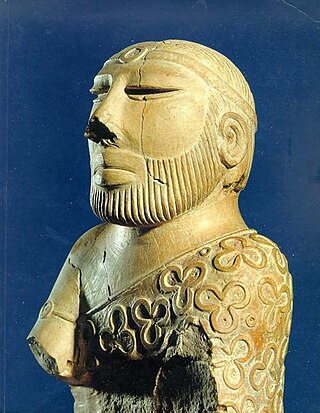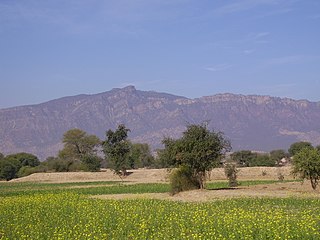
Mehrgarh is a Neolithic archaeological site situated on the Kacchi Plain of Balochistan in Pakistan. It is located near the Bolan Pass, to the west of the Indus River and between the modern-day Pakistani cities of Quetta, Kalat and Sibi. The site was discovered in 1974 by the French Archaeological Mission led by the French archaeologists Jean-François Jarrige and his wife, Catherine Jarrige. Mehrgarh was excavated continuously between 1974 and 1986, and again from 1997 to 2000. Archaeological material has been found in six mounds, and about 32,000 artifacts have been collected from the site. The earliest settlement at Mehrgarh—located in the northeast corner of the 495-acre (2.00 km2) site—was a small farming village dated between 7000 BCE and 5500 BCE.

The Oldowan was a widespread stone tool archaeological industry (style) in prehistory. These early tools were simple, usually made with one or a few flakes chipped off with another stone. Oldowan tools were used during the Lower Paleolithic period, 2.9 million years ago up until at least 1.7 million years ago (Ma), by ancient Hominins across much of Africa. This technological industry was followed by the more sophisticated Acheulean industry.
Jonathan Mark Kenoyer is an American archaeologist and George F. Dales Jr. & Barbara A. Dales Professor of Anthropology at the University of Wisconsin–Madison. He earned his Bachelor of Arts, Master's, and Doctorate degrees at the University of California, Berkeley, finishing in 1983. Kenoyer is president of the Society of Bead Researchers.

Allama Iqbal Colony is a residential neighbourhood in Lyari Town, located in the Karachi South district of Karachi, Pakistan.

The South Asian Stone Age covers the Palaeolithic, Mesolithic and Neolithic periods in the Indian subcontinent. Evidence for the most ancient Homo sapiens in South Asia has been found in the cave sites of Cudappah of India, Batadombalena and Belilena in Sri Lanka. In Mehrgarh, in what is today western Pakistan, the Neolithic began c. 7000 BCE and lasted until 3300 BCE and the first beginnings of the Bronze Age. In South India, the Mesolithic lasted until 3000 BCE, and the Neolithic until 1400 BCE, followed by a Megalithic transitional period mostly skipping the Bronze Age. The Iron Age in India began roughly simultaneously in North and South India, around c. 1200 to 1000 BCE.

Rawalpindi is a tehsil - an administrative subdivision - of Rawalpindi District in the western part of the Punjab province, Pakistan, it contains the district capital - the city of Rawalpindi.

This is a timeline of Pakistani history, comprising important legal and territorial changes and political events in the region of modern-day's Pakistan. To read about the background of these events, see History of Pakistan and History of the Islamic Republic of Pakistan.
Ghora Gali is one of the tourist mountain resort towns of the Galyat area of northern Pakistan. It has an elevation of 1691m and is located in the northeastern tip of the Punjab province of Pakistan. Ghora Gali is also a Union council, an administrative subdivision, of Murree Tehsil in Murree District and is located at 33.83°N 73.35°E. According to the 1998 census of Pakistan, it had a population of 14410.
Rawat is a village and union council of Murree Tehsil in the Murree District of Punjab, Pakistan. It is located in the north of the country in the hilly part of Punjab province, near the border with Khyber Pakhtunkhwa and Kashmir. The tourist resort of Bhurban is located here.

The Aiwan-e-Sadr, or Presidential Palace, is the official residence and workplace of the President of Pakistan. It is located in northeastern Islamabad on Constitution Avenue, between the Parliament Building and the Cabinet block of the Pakistan Secretariat. Residences for the Presidential staff, known as the President's Colony, are also located behind the Presidency, adjacent to 4th Avenue.

Havelian Tehsil is an administrative subdivision (tehsil) of Abbottabad District in the Khyber Pakhtunkhwa province of Pakistan.

Haranpur is a town and union council of Pind Dadan Khan Tehsil in Jhelum District, Punjab province, Pakistan, it is located at 32°36'11N 73°8'53E. During British rule a bridge was built for the Sindsagar line of the North-Western Railway. On the opposite side of the river, at a distance of about 5 miles, lies the old town of Mieni, once a place of distinct importance.

Bhata is a village in Pakistan which is located in the centre of Mandra-Chowk Pindori Road, Tehsil Gujar Khan, Rawalpindi District.
Motian is a village in Jhelum District, Punjab province, Pakistan.
Chitti Gatti is a hamlet located in Gandhian (village) of Inayatabad union council, of Mansehra area, of Hazara, Khyber-Pakhtunkhwa, Pakistan. Since early times, it is especially notable for two Hindu festivals which occur on 6th Phagan and on 1st Baisakh, as mentioned by an early Settlement Report;, dedicated to the worship of the deity Shiva. The present old Mansehra Shiva Temple here on this site, which has been recently restored, was originally constructed by a Raja of Jammu in the 1830s as an act of devotion. According to the latest archaeological research, there were probably earlier Hindu temples on this same site, but the ancient Shiva Lingam inside the temple's precincts is truly ancient and at least 2000 years old. The temple and Lingam still attract many Hindu pilgrims and tourists each year, especially at the time of the annual Maha Shivratri festival.

Gurdwara Janam Asthan, also referred to as Gurdwara Nankana Sahib, is a highly revered gurdwara that is situated at the site where the founder of Sikhism, Guru Nanak, was born. The shrine is located in Nankana Sahib, Punjab, Pakistan.

Shakarparian is a hill, and a national park located near the Zero Point Interchange in Islamabad, Pakistan. Pakistan Monument and Pakistan Monument Museum are also located in Shakarparian.

Bakrala Railway Station is located in Bakrala village, Sohawa Tehsil, Jhelum district, Punjab province, Pakistan.

Missa Keswal Railway Station is located in Missa Keswal, Jhelum district of Punjab province of the Pakistan.














